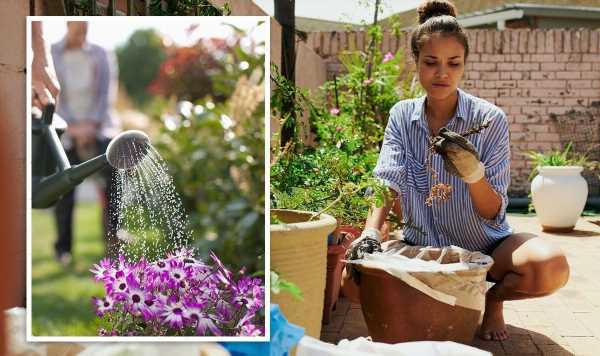Gardening: How to create a watering tool for your plants
We use your sign-up to provide content in ways you’ve consented to and to improve our understanding of you. This may include adverts from us and 3rd parties based on our understanding. You can unsubscribe at any time. More info
As the hotter, dryer days of summer arrive, your plant watering schedule may need some tweaks to ensure flowers stay hydrated. However, this can often lead to gardeners over or under-watering their greenery.
According to William Mitchell of Sutton Manor Nursery, this is “without a doubt the most common mistake” gardeners make.
He explained: “The problem is most plants have different requirements when it comes to watering and not many people are fully aware of this.
“Under-watering to one plant may be over watering to another, so you have to be very careful.”
The best way to understand your plant’s specific needs is by doing some research.


Mr Mitchell added: “One of the most important things to remember is to not water your plants too frequently. However, this does not mean that you should not water them at all.
“During warmer weather, it can be extremely tempting to water your crops more frequently.
“Watering them less frequently, but making sure that when you water the plant you make sure that you thoroughly saturate the soil is the most effective way of watering.
“This way of watering helps to encourage the roots to reach deeply for residual water, even when the soil surface appears dry.”
There are also some easy ways to spot whether your plant has had too much water or if it is yearning for another drop.
DON’T MISS
Monty Don shares when to deadhead salvia to ‘prolong flowering’ [COMMENT]
How to make ‘cheap and effective’ weed killer [INSIGHT]
How to stop plants wilting in the heat – 5 ways to revive your plants [EXPLAINER]
Signs your plant needs more water
Mr Mitchell explained: “There are many ways that you can spot signs of either overwatering or underwatering plants.
“Underwatering plants will have signs such as dry leaves, brown tips, leaf curling and even leaf dropping.”
Gardeners can also use the soil surrounding their plant as an indicator of how much water it needs.
According to Gardening Know How: “If the soil around a plant is dry, it may need more water.
“Exceptions to this are some succulents, like cacti, which don’t need much water because they can store it so well.”
Get the latest three-day weather forecast where you live. Find out by adding your postcode or visit InYourArea
Signs you have overwatered your plants
Though plants need water to survive, too much water can be detrimental to your garden flora.
Mr Mitchell said: “Overwatered plants will have signs such as yellowing leaves, brown tips, wilting despite wet soil and in the worst cases even root rot.”
You may also notice water beginning to build or pool in the surrounding soil.
Source: Read Full Article
